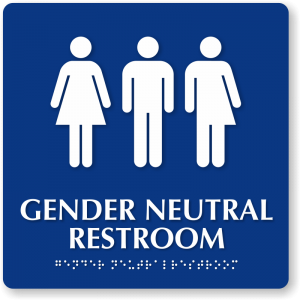
A gender neutral restroom will soon be added to the University Student Center for use by all students regardless of gender identity or expression.
What started as a mere suggestion by Gay Straight Alliance President Danielle Merewether has become a reality. Last week, Merewether met with Dwayne Isaacs, assistant director of the USC, to go over final details for placing a gender neutral sign on a pre-existing restroom.
The sign will go outside the restroom currently labeled as Americans with Disabilities Act accessible. It will continue to serve students in need of ADA accessibility, as well as those seeking a restroom free of gender identity.
Gender neutral restrooms, defined by the University of California, are usually single-stall facilities that a person of any gender can feel safe using.
“It is good to have a safe environment (for transgender and gender neutral peo
ple on campus) to do something as simple as going to the bathroom,” Merewether said.
Merewether was surprised by the positivity and openness from campus faculty and staff after hearing the idea of gender neutral restrooms.
“We are very excited about the project because it sends a great message to the USFSP community, and it is yet another step towards making the USC feel like home to all students,” Isaacs said.
Deni Elliott, ethics specialists and chair of the Journalism and Media Studies Department, said, “I am in favor (of gender neutral bathrooms) because it shows sensitivity to transgender people.”
Students casually polled on campus responded positively to the idea.
A June 2013 study by the University of California School of Law titled “Gendered Restrooms and Minority Stress: The Public Regulation of Gender and its Impact on Transgender People’s Lives,” shows the negative impact gender-specific restrooms have on people who identify as transgender and gender-nonconforming individuals.
“All people share the real human need for safe restroom facilities when we go to work, go to school and participate in public life,” concluded Jody L. Herman, author of the study.
In the study, the percentage of individuals affected adversely by gender specific restrooms was high. Fear of verbal harassment or physical assault, often deter transgender and gender-nonconforming people from even using the sex-segregated bathrooms, causing physical ailments like urinary tract infections, dehydration and kidney infections.
In March 2013, a high school in Portland, Ore., remodeled six existing bathrooms to be gender neutral and for single-person use. The simple change was made after hearing concerns from LGBT students who didn’t feel comfortable using the restrooms at school. One senior, who was born female but now identifies as male, said he would avoid drinking fluids at school as to avoid using the restroom, according to an article from ABC News.
“The way we have bathrooms set up now … reinforces the strict gender binary. Unisex bathrooms say ‘this is a bathroom people can use.’ Transgender students face potential issues when it comes to the traditional binary bathroom setup. Unisex bathrooms would make the university a potentially more comfortable space for transgender and gender-nonconforming students, faculty and staff,” said a graduate student who wishes to remain anonymous.
The exact date of the change to the restroom in the USC has not been determined, but new signage will be added before the end of the spring 2014 semester.
For more information about the USFSP Gay Straight Alliance visit its OrgSync page. The organization meets every Wednesday at 8 p.m in the Palm Room of the USC. President Danielle Merewether can also be reached via email at merewether@mail.usf.edu.



